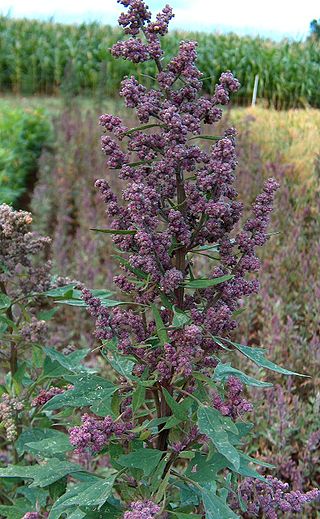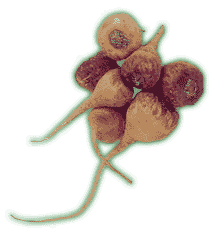
Amaranthus is a cosmopolitan group of more than 50 species which make up the genus of annual or short-lived perennial plants collectively known as amaranths. Some of the more well known names include "prostrate pigweed" and "love lies bleeding". Some amaranth species are cultivated as leaf vegetables, pseudocereals, and ornamental plants. Catkin-like cymes of densely packed flowers grow in summer or fall. Amaranth varies in flower, leaf, and stem color with a range of striking pigments from the spectrum of maroon to crimson and can grow longitudinally from 1 to 2.5 metres tall with a cylindrical, succulent, fibrous stem that is hollow with grooves and bracteoles when mature. There are approximately 75 species in the genus, 10 of which are dioecious and native to North America with the remaining 65 monoecious species endemic to every continent from tropical lowlands to the Himalayas. Members of this genus share many characteristics and uses with members of the closely related genus Celosia. Amaranth grain is collected from the genus. The leaves of some species are also eaten.

Quinoa is a flowering plant in the amaranth family. It is a herbaceous annual plant grown as a crop primarily for its edible seeds; the seeds are rich in protein, dietary fiber, B vitamins and dietary minerals in amounts greater than in many grains. Quinoa is not a grass but rather a pseudocereal botanically related to spinach and amaranth, and originated in the Andean region of northwestern South America. It was first used to feed livestock 5,200–7,000 years ago, and for human consumption 3,000–4,000 years ago in the Lake Titicaca basin of Peru and Bolivia.

Oxalis tuberosa is a perennial herbaceous plant that overwinters as underground stem tubers. These tubers are known as uqa in Quechua, oca in Spanish, yams in New Zealand and a number of other alternative names. The plant was brought into cultivation in the central and southern Andes for its tubers, which are used as a root vegetable. The plant is not known in the wild, but populations of wild Oxalis species that bear smaller tubers are known from four areas of the central Andean region. Oca was introduced to Europe in 1830 as a competitor to the potato, and to New Zealand as early as 1860.

Ullucus is a genus of flowering plants in the family Basellaceae, with one species, Ullucus tuberosus, a plant grown primarily as a root vegetable, secondarily as a leaf vegetable. The name ulluco is derived from the Quechua word ulluku, but depending on the region, it has many different names. These include illaco, melloco, chungua or ruba, olluco or papalisa, or ulluma.

Lepidium meyenii, known as maca or Peruvian ginseng, is an edible herbaceous biennial plant of the family Brassicaceae that is native to South America in the high Andes mountains of Peru and Bolivia. It was rediscovered for commercial purposes at the Meseta de Bombón plateau close to Lake Junin in the late 1980s. It is grown for its fleshy hypocotyl that is fused with a taproot, which is typically dried, but may also be freshly cooked as a root vegetable. As a cash crop, it is primarily exported as a powder that may be raw, or processed further as a gelatinized starch or as an extract. If dried, it may be processed into a flour for baking or as a dietary supplement.

Chenopodium pallidicaule, known as cañihua, canihua or cañahua and also kaniwa, is a species of goosefoot, similar in character and uses to the closely related quinoa.

Lupinus mutabilis is a species of lupin grown in the Andes, mainly for its edible bean. Vernacular names include tarwi, chocho, altramuz, Andean lupin, South American lupin, Peruvian field lupin, and pearl lupin. Its nutrient-rich seeds are high in protein, as well as a good source for cooking oil. However, their bitter taste has made L. mutabilis relatively unknown outside the Andes, though modern technology makes it easier to remove the bitter alkaloids. Like other species of lupin beans, it is expanding in use as a plant-based protein source.
Mirabilis expansa is a species of flowering plant cultivated as a root vegetable in the Andes, at cold, windy altitudes between 2,200 m (7,200 ft) and 3,500 m (11,500 ft). The above-ground portion dies back with frost, but the root is quite hardy. The roots can reach the size of a man's forearm, and yields can reach 50,000 kg/ha (45,000 lb/acre) given two years maturation time.

A pseudocereal or pseudograin is one of any non-grasses that are used in much the same way as cereals. Pseudocereals can be further distinguished from other non-cereal staple crops by their being processed like a cereal: their seed can be ground into flour and otherwise used as a cereal. Prominent examples of pseudocereals include amaranth, quinoa, and buckwheat. The pseudocereals have a good nutritional profile, with high levels of essential amino acids, essential fatty acids, minerals, and some vitamins. The starch in pseudocereals has small granules and low amylose content, which gives it similar properties to waxy-type cereal starches. The functional properties of pseudocereals, such as high viscosity, water-binding capacity, swelling capability, and freeze-thaw stability, are determined by their starch properties and seed morphology. Pseudocereals are gluten-free, and they are used to make 100% gluten-free products, which has increased their popularity.

Amaranthus viridis is a cosmopolitan species in the botanical family Amaranthaceae and is commonly known as slender amaranth or green amaranth.

Amaranthus retroflexus is a species of flowering plant in the family Amaranthaceae with several common names, including red-root amaranth, redroot pigweed, red-rooted pigweed, common amaranth, pigweed amaranth, and common tumbleweed.

Amaranthus cruentus is a flowering plant species that yields the nutritious staple amaranth grain. It is one of three Amaranthus species cultivated as a grain source, the other two being Amaranthus hypochondriacus and Amaranthus caudatus. It has several common names, including blood amaranth, red amaranth, purple amaranth, prince's feather, and Mexican grain amaranth.

Species belonging to the genus Amaranthus have been cultivated for their grains for 8,000 years. Amaranth plants are classified as pseudocereals that are grown for their edible starchy seeds, but they are not in the same botanical family as true cereals, such as wheat and rice. Amaranth species that are still used as a grain are Amaranthus caudatus L., Amaranthus cruentus L., and Amaranthus hypochondriacus L. The yield of grain amaranth is comparable to that of rice or maize.

Chenopodium berlandieri, also known by the common names pitseed goosefoot, lamb's quarters, and huauzontle (Nahuatl) is an annual herbaceous plant in the family Amaranthaceae.

Incan agriculture was the culmination of thousands of years of farming and herding in the high-elevation Andes mountains of South America, the coastal deserts, and the rainforests of the Amazon basin. These three radically different environments were all part of the Inca Empire and required different technologies for agriculture. Inca agriculture was also characterized by the variety of crops grown, the lack of a market system and money, and the unique mechanisms by which the Incas organized their society. Andean civilization was "pristine"—one of six civilizations worldwide which were indigenous and not derivative from other civilizations. Most Andean crops and domestic animals were likewise pristine—not known to other civilizations. Potatoes and quinoa were among the many unique crops; Camelids and guinea pigs were the unique domesticated animals.

Erythrina edulis (basul) is a nitrogen fixing tree that is native to the Andean region from western Venezuela to southern Bolivia. Nowadays it is known in Venezuela as "frijol mompás", in Bolivia, Peru and Northwest Argentina as "psonay", "pajuro", "sachaporoto del basul" or "poroto del sacha", in Colombia as "chachafruto", "balú", "baluy" or "sachaporoto" and in Ecuador as "guato". Although it is widely known, it is not commonly cultivated. Future research is needed, especially in agroforestry. Basul is a legume and so it produces protein-rich beans covered in pods which can be used for human or animal nutrition. The leaves and branches can be used as fodder. Besides the agricultural aspects, Erythrina edulis can also be used as a fence plant.

A grain is a small, hard, dry fruit (caryopsis) – with or without an attached hull layer – harvested for human or animal consumption. A grain crop is a grain-producing plant. The two main types of commercial grain crops are cereals and legumes.

Pachyrhizus ahipa, also called the ahipa or Andean yam bean, is a tuberous root-producing legume, which is mainly distributed in the Andean region.

A staple food, food staple, or simply staple, is a food that is eaten often and in such quantities that it constitutes a dominant portion of a standard diet for an individual or a population group, supplying a large fraction of energy needs and generally forming a significant proportion of the intake of other nutrients as well. For humans, a staple food of a specific society may be eaten as often as every day or every meal, and most people live on a diet based on just a small variety of food staples. Specific staples vary from place to place, but typically are inexpensive or readily available foods that supply one or more of the macronutrients and micronutrients needed for survival and health: carbohydrates, proteins, fats, minerals, and vitamins. Typical examples include grains, seeds, nuts and root vegetables. Among them, cereals, legumes and tubers account for about 90% of the world's food calorie intake.

Ancient grains is a marketing term used to describe a category of grains and pseudocereals that are purported to have been minimally changed by selective breeding over recent millennia, as opposed to more widespread cereals such as corn, rice and modern varieties of wheat, which are the product of thousands of years of selective breeding. Ancient grains are often marketed as being more nutritious than modern grains, though their health benefits over modern varieties have been disputed by some nutritionists.



















